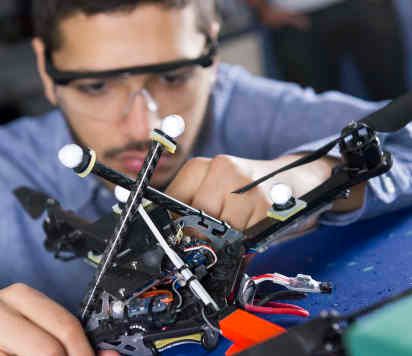 It is with great sadness that we announce the death of our long-standing colleague, Professor Peter Bradshaw, on Saturday 27 July 2024.
It is with great sadness that we announce the death of our long-standing colleague, Professor Peter Bradshaw, on Saturday 27 July 2024.
Peter Bradshaw undertook his B.A. in Aeronautical Engineering at Cambridge University in 1957, and worked in the Aerodynamics Division of the National Physical Laboratory until 1969. He then joined the Department of Aeronautics, Imperial College London, where he was Professor of Experimental Aerodynamics and Head of Aerodynamics until 1988 when he took up the newly-endowed Thomas V. Jones Chair of Engineering at Stanford University (Emeritus from 1995).
Peter’s experiences at Cambridge were formative: on graduation, he began but did not complete a PhD with the great fluid dynamicist, Professor Alan Townsend. Nonetheless, the seed was sown and along with several other leading fluid dynamicists, Peter took up a position of Scientific Officer under the tutelage of Dr R. C. Pankhurst, Superintendent of the NPL Aerodynamics Division from 1964 to 1970. During this period, Peter worked on the development of low-speed wind tunnels largely for aeronautical applications – an indication of his more practical contributions to come. The pragmatic side to his work marked him out as a pioneer in experimental methods, most notably in what was to follow during the introduction of digital electronics to experimental aerodynamics for both data acquisition and computational analysis.
However, it was probably Peter’s insights and his wonderful expression of them in the scientific literature that marked out his increasing scientific stature. Still in his thirties, he produced a string of seminal papers while at the NPL that established his credentials on the international stage. At a highly influential meeting at Stanford University in 1968, Professor Steve Kline (Thermosciences Division, Stanford University) remarked in reference to Peter’s contributions (note the under-stated style): “Let me start by saying that his comments are quite useful as I would expect since he appears to see farther into the nature of turbulence than most other workers at this time.” By this stage, Peter had become internationally renowned in turbulence and experimental aerodynamics in particular.
In 1969, Peter moved to the Department of Aeronautics, initially as Reader. In 1981, he was both promoted to a Professor and elected to the Fellowship of the Royal Society. Further awards followed: he was Prince Distinguished Lecturer at Arizona State University in 1982, and Distinguished Lecturer in Mechanical Engineering at Michigan State University in 1987. In 1990 he was awarded the honorary degree of DSc by Exeter University, close to his native Torquay. In 1992-1993 he was an ASME Distinguished Lecturer, and in 1994 he received the AIAA Fluid Dynamics Award.
Peter was unquestionably a leader in turbulent shear flows. While he always provided insight, he sought pragmatic solutions too. Never a huge believer in the eddy viscosity hypothesis which was (and is) used extensively for industrial predictions, he introduced his own calculation method that removed the need for the assumption and was faster. At the time, the latter was a prerequisite for viable prediction methods. The Bradshaw, Ferris, Atwell code was one of the two that swept the board in the “Stanford Olympics” of 1968.
In the early seventies, exploiting his knowledge of wind tunnel design gained while at NPL, he introduced a suite of small blower tunnels with wide-angle diffusers that appeared in several labs in the Aeronautics Department. In the early eighties, with the aid of a BBC Micro computer mounted on a wooden tray that fitted into his briefcase, he pioneered the introduction of digital data acquisition in the wind tunnel, rendering analogue tape recording obsolete. These tunnels were ideal for the development of a range of turbulent shear layers with complicated boundary conditions – the effects of pressure gradient, separation and reattachment, compressible flow, and heat transfer. The ensuing experiments all contributed data for the development of Peter’s ideas around complex shear layers – those in which shear layers with “extra rates of strain” exhibited effects that were much larger than might be expected and which were due to the inherent nonlinearity of the governing equations of motion. This was arguably the golden period of Peter’s career – an unquestionable need for insightful experiments with complicated boundary conditions well before comparable simulations were possible.
Many of Peter’s experiments performed in the Department brought new insights, often unifying an understanding of processes in Fourier space with those in physical space. Peter’s work on 3D turbulent boundary layers has led to new recent interest in how travelling surface waves can reduce friction drag.
There are many anecdotes that illustrate the richness and complexity of Peter’s life. Nearly all generate laughter, at both his expense (the collapse of the suspension on his beloved Triumph Spitfire) as well as those of others (the “chimney doctors”). While he was not a great attender of scientific meetings, his reputation certainly produced a string of visitors to Imperial. Peter’s response was to offer a recorded guided tour on a portable cassette recorder, the unsuspecting visitor being treated to Peter’s heavy breathing on reaching the top of the stairs. A note of such idiosyncrasies appeared in the London Evening Standard of the time.
Peter moved to Stanford in 1988, living in the Bay Area until 2017 when he moved to Las Vegas. He often referred to his former group members, students and colleagues as his ‘family’, circulating a Christmas newsletter until well after his retirement at Stanford. He inspired a whole generation of young researchers, several of whom have gone on to notable careers of their own. He instilled in them not just a passion for the subject, but an awe for his intellect. He is fondly remembered as a giant in our subject.
Jonathan Morrison


